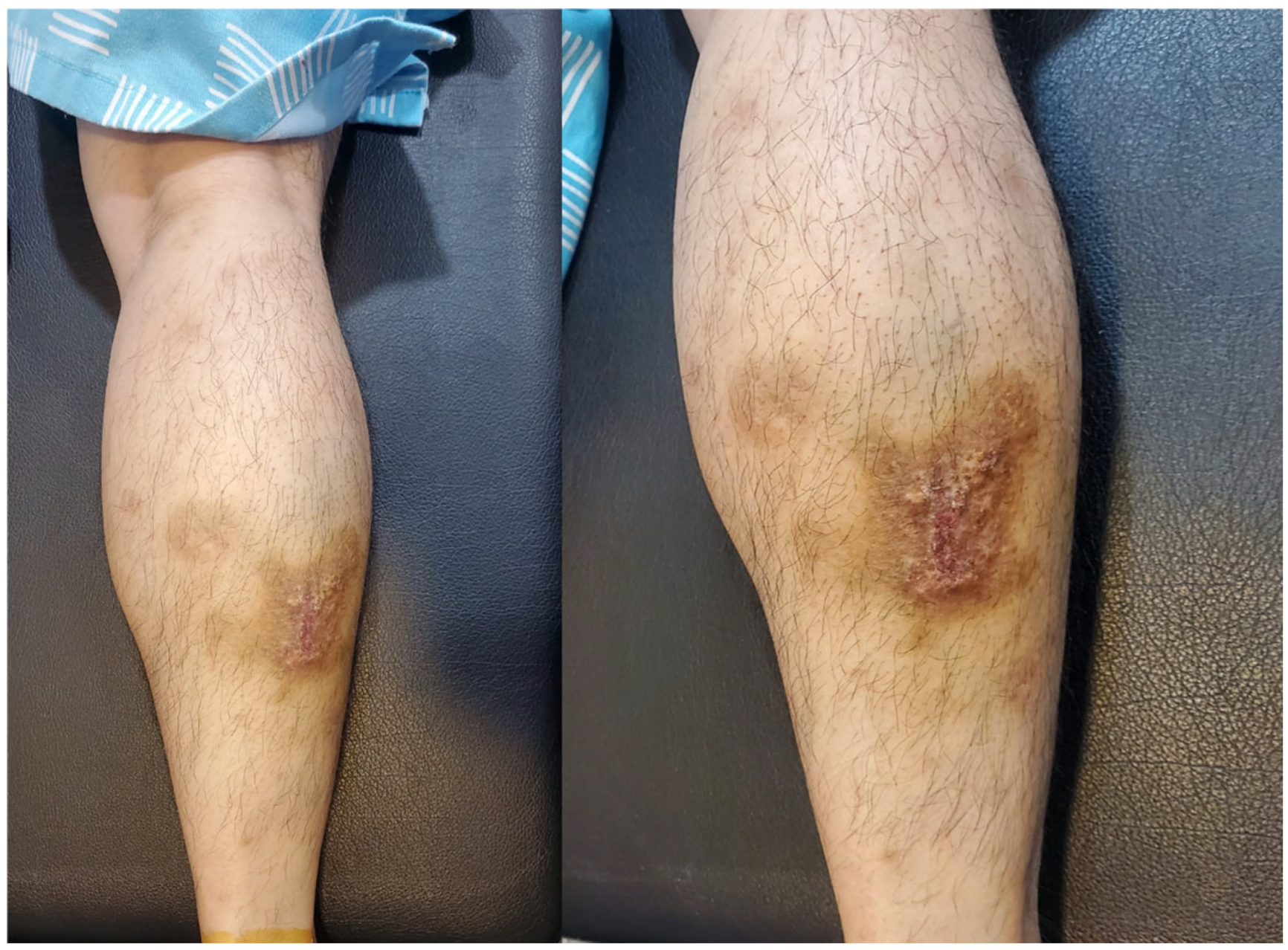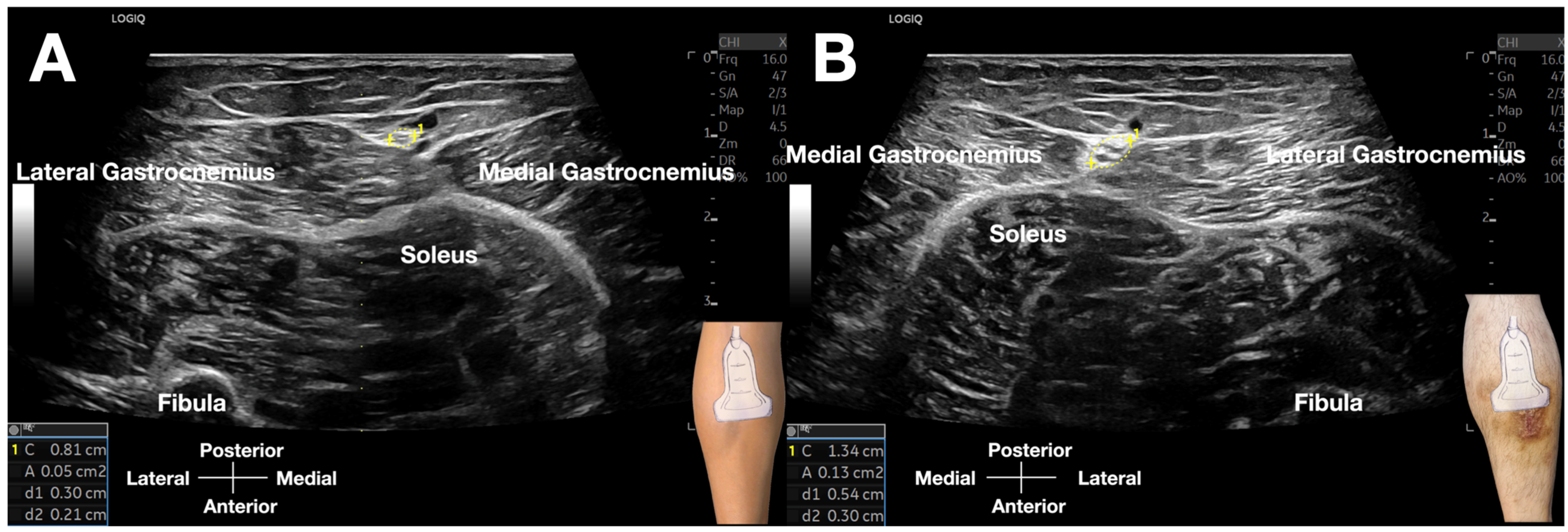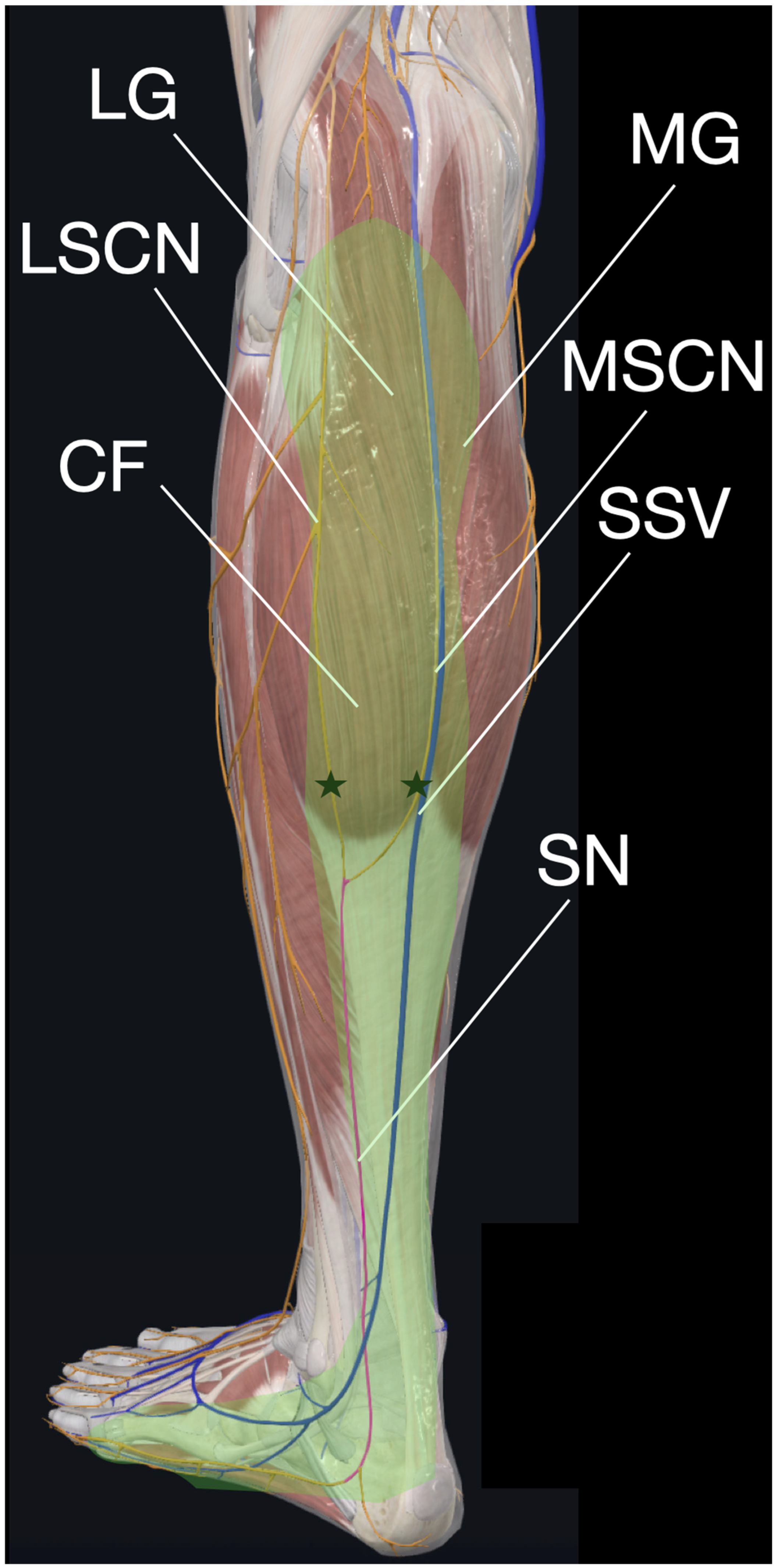Novel Sonoguided Digital Palpation and Hydrodissection for Sural Nerve Dysfunction Mimicking Achilles Tendinopathy in a Psoriasis Patient
Abstract
1. Introduction
2. Case Presentation
2.1. Diagnosis of Sural Nerve Involvement Using Sonoguide Digital Palpation
2.2. Ultrasound-Guided Hydrodissection for Sural Nerve Dysfunction
3. Discussion
3.1. Neuropathic Pain in Psoriatic Arthritis: An Unexplored Mechanistic Pathway
3.2. Diagnostic Paradigm Shift: Moving Beyond Traditional Limitations
3.3. Mechanistic Advantages of Fascial-Targeted Approach
- Fascial changes: Chronic inflammation induces fascial fibrosis and reduced mobility, restricting nerve gliding and increasing entrapment susceptibility [55].
3.4. The Koebner Phenomenon and Potential Neural Involvement
4. Limitations
5. Conclusions
Supplementary Materials
Author Contributions
Funding
Institutional Review Board Statement
Informed Consent Statement
Data Availability Statement
Conflicts of Interest
References
- Campanati, A.; Marani, A.; Martina, E.; Diotallevi, F.; Radi, G.; Offidani, A. Psoriasis as an Immune-Mediated and Inflammatory Systemic Disease: From Pathophysiology to Novel Therapeutic Approaches. Biomedicines 2021, 9, 1511. [Google Scholar] [CrossRef]
- Fiorenza, A.; Bonitta, G.; Gerratana, E.; Marino, F.; Sarzi-Puttini, P.; Salaffi, F.; Atzeni, F. Assessment of enthesis in patients with psoriatic arthritis and fibromyalgia using clinical examination and ultrasound. Clin. Exp. Rheumatol. 2020, 38 (Suppl. S123), 31–39. [Google Scholar] [PubMed]
- Nugroho, N.; Lam, K.H.S.; Tandiono, T.; Suryadi, T.; Suhaimi, A.; Ratnawati, W.; Su, D.C.-J.; Yoon, Y.; Reeves, K.D. Novel Sonoguided Digital Palpation and Ultrasound-Guided Hydrodissection of the Long Thoracic Nerve for Managing Serratus Anterior Muscle Pain Syndrome: A Case Report with Technical Details. Diagnostics 2025, 15, 1891. [Google Scholar] [CrossRef] [PubMed]
- Paraskevas, G.K.; Natsis, K.; Tzika, M.; Ioannidis, O. Fascial entrapment of the sural nerve and its clinical relevance. Anat. Cell Biol. 2014, 47, 144–147. [Google Scholar] [CrossRef][Green Version]
- Aktan Ikiz, Z.A.; Uçerler, H.; Bilge, O. The anatomic features of the sural nerve with an emphasis on its clinical importance. Foot Ankle Int. 2005, 26, 560–567. [Google Scholar] [CrossRef]
- Fenech, M. Sonographic imaging and assessment of the sural nerve. Sonography 2023, 10, 166–174. [Google Scholar] [CrossRef]
- Spinnato, P.; Patel, D.B.; Di Carlo, M.; Bartoloni, A.; Cevolani, L.; Matcuk, G.R.; Crombé, A. Imaging of Musculoskeletal Soft-Tissue Infections in Clinical Practice: A Comprehensive Updated Review. Microorganisms 2022, 10, 2329. [Google Scholar] [CrossRef]
- Zaidman, C.M.; Seelig, M.J.; Baker, J.C.; Mackinnon, S.E.; Pestronk, A. Detection of peripheral nerve pathology: Comparison of ultrasound and MRI. Neurology 2013, 80, 1634–1640. [Google Scholar] [CrossRef]
- Callaghan, B.C.; Burke, J.F.; Feldman, E.L. Electrodiagnostic Tests in Polyneuropathy and Radiculopathy. JAMA 2016, 315, 297–298. [Google Scholar] [CrossRef]
- Rubin, D.I.; Lamb, C.J. The role of electrodiagnosis in focal neuropathies. Handb. Clin. Neurol. 2024, 201, 43–59. [Google Scholar]
- Dy, C.J.; Colorado, B.S.; Landau, A.J.; Brogan, D.M. Interpretation of Electrodiagnostic Studies: How to Apply It to the Practice of Orthopaedic Surgery. J. Am. Acad. Orthop. Surg. 2021, 29, e646–e654. [Google Scholar] [CrossRef] [PubMed]
- Canham, L.J.W.; Kane, N.M.; Cottrell, D.A. The potential of visual physiology: An instrument with a place in MS translation. Clin. Neurophysiol. Pract. 2019, 4, 112–113. [Google Scholar] [CrossRef] [PubMed]
- Malessy, M.J.A.; De Boer, R.; Romero, I.M.; Eekhof, J.L.A.; Van Zwet, E.W.; Kliot, M.; Dahan, A.; Pondaag, W. Predictive value of a diagnostic block in focal nerve injury with neuropathic pain when surgery is considered. PLoS ONE 2018, 13, e0203345. [Google Scholar] [CrossRef] [PubMed]
- Hetland, M.L. DANBIO–powerful research database and electronic patient record. Rheumatology 2011, 50, 69–77. [Google Scholar] [CrossRef]
- Rifbjerg-Madsen, S.; Christensen, A.W.; Christensen, R.; Hetland, M.L.; Bliddal, H.; Kristensen, L.E.; Danneskiold-Samsøe, B.; Amris, K. Pain and pain mechanisms in patients with inflammatory arthritis: A Danish nationwide cross-sectional DANBIO registry survey. PLoS ONE 2017, 12, e0180014. [Google Scholar] [CrossRef]
- Kiliçoğlu, M.S.; Kara, M.; Yurdakul, O.V. Neuropathic Pain in Patients with Psoriatic Arthritis: A Bystander or a Gamechanger? Sak. Tıp Derg. 2023, 13, 412–420. [Google Scholar] [CrossRef]
- Tople, J.P.; Bhuyan, D. Ultrasound-guided Hydrodissection of Sural Nerve for Foot Pain. J. Pharm. Res. Int. 2021, 33, 513–518. [Google Scholar] [CrossRef]
- Bianchi, S.; Droz, L.; Deplaine, C.L.; Dubois-Ferriere, V.; Delmi, M. Ultrasonography of the sural nerve: Normal and pathologic appearances. J. Ultrasound Med. 2018, 37, 1257–1265. [Google Scholar] [CrossRef]
- Brown, M.N.; Pearce, B.S.; Vanetti, T.K. Sural nerve entrapment. In Peripheral Nerve Entrapments: Clinical Diagnosis and Management; Springer: Cham, Switzerland, 2016; pp. 795–810. [Google Scholar]
- Hirose, C.B.; McGarvey, W.C. Peripheral nerve entrapments. Foot Ankle Clin. 2004, 9, 255–269. [Google Scholar] [CrossRef]
- Barker-Davies, R.M.; Baker, P.; Watson, J.; Goodall, D.; Wheeler, P.C.; Nicol, A.M.; Fong, D.T.; Lewis, M.P.; Bennett, A.N. High-Volume Image-Guided Injections in Achilles and Patellar Tendinopathy in a Young Active Military Population: A Double-Blind Randomized Controlled Trial. Orthop. J. Sports Med. 2022, 10, 23259671221088326. [Google Scholar] [CrossRef]
- Liu, Z.; Wang, Q.; Sun, W.; Song, Q. Balancing sensory inputs: Somatosensory reweighting from proprioception to tactile sensation in maintaining postural stability among older adults with sensory deficits. Front. Public Health 2023, 11, 1165010. [Google Scholar] [CrossRef]
- Carroll, M.; Parmar, P.; Dalbeth, N.; Boocock, M.; Rome, K. Gait characteristics associated with the foot and ankle in inflammatory arthritis: A systematic review and meta-analysis. BMC Musculoskelet. Disord. 2015, 16, 134. [Google Scholar] [CrossRef]
- Lam, K.H.S.; Hung, C.-Y.; Chiang, Y.-P.; Onishi, K.; Su, D.C.J.; Clark, T.B.; Reeves, K.D. Ultrasound-Guided Nerve Hydrodissection for Pain Management: Rationale, Methods, Current Literature, and Theoretical Mechanisms. J. Pain Res. 2020, 13, 1957–1968. [Google Scholar] [CrossRef]
- Lee, H.W.; Hwang, J.; Park, C.; Lee, M.; Yoon, Y.; Seo, Y.-S.; Yu, H.; Park, R.; Shim, J.; Ann, J.; et al. Confirming the Presence of Neurapraxia and Its Potential for Immediate Reversal by Novel Diagnostic and Therapeutic Ultrasound-Guided Hydrodissection Using 5% Dextrose in Water Without Local Anesthetics: Application in a Case of Acute Radial Nerve Palsy. Diagnostics 2025, 15, 1880. [Google Scholar] [CrossRef]
- Omodani, T.; Takahashi, K. Ultrasound-Guided Hydrodissection for Sural Neuropathy After Calcaneus Fracture Surgery: A Case Report. Cureus 2023, 15, e47749. [Google Scholar] [CrossRef]
- Fader, R.R.; Mitchell, J.J.; Chadayammuri, V.P.; Hill, J.; Wolcott, M.L. Percutaneous Ultrasound-Guided Hydrodissection of a Symptomatic Sural Neuroma. Orthopedics 2015, 38, e1046–e1050. [Google Scholar] [CrossRef]
- Lam, K.H.S.; Wu, Y.-T.; Reeves, K.D.; Galluccio, F.; Allam, A.E.-S.; Peng, P.W.H. Ultrasound-Guided Interventions for Carpal Tunnel Syndrome: A Systematic Review and Meta-Analyses. Diagnostics 2023, 13, 1138. [Google Scholar] [CrossRef] [PubMed]
- Chan, O.; O’Dowd, D.; Padhiar, N.; Morrissey, D.; King, J.; Jalan, R.; Maffulli, N.; Crisp, T. High volume image guided injections in chronic Achilles tendinopathy. Disabil. Rehabil. 2008, 30, 1697–1708. [Google Scholar] [CrossRef]
- Kakkos, G.A.; Klontzas, M.E.; Koltsakis, E.; Karantanas, A.H. US-guided high-volume injection for Achilles tendinopathy. J. Ultrason. 2021, 21, e127–e133. [Google Scholar] [CrossRef] [PubMed]
- Nielsen, T.G.; Miller, L.L.; Mygind-Klavsen, B.; Lind, M. The effect of high-volume image-guided injection in the chronic non-insertional Achilles tendinopathy: A retrospective case series. J. Exp. Orthop. 2020, 7, 45. [Google Scholar] [CrossRef] [PubMed]
- King, H.H. Addition of Osteopathic Visceral Manipulation to OMT for Low Back Pain Decreases Pain and Increases Quality of Life. J. Am. Osteopat. Assoc. 2017, 117, 333–334. [Google Scholar] [CrossRef][Green Version]
- Eguaras, N.; Rodríguez-López, E.S.; Lopez-Dicastillo, O.; Franco-Sierra, M.Á.; Ricard, F.; Oliva-Pascual-Vaca, Á. Effects of Osteopathic Visceral Treatment in Patients with Gastroesophageal Reflux: A Randomized Controlled Trial. J. Clin. Med. 2019, 8, 1738. [Google Scholar] [CrossRef]
- Guillaud, A.; Darbois, N.; Monvoisin, R.; Pinsault, N. Reliability of diagnosis and clinical efficacy of visceral osteopathy: A systematic review. BMC Complement. Altern. Med. 2018, 18, 65. [Google Scholar] [CrossRef]
- Seffinger, M.A. Foundations of Osteopathic Medicine: Philosophy, Science, Clinical Applications, and Research, 4th ed.; Wolters Kluwer: Alphen aan den Rijn, The Netherlands, 2018. [Google Scholar]
- Mologne, M.S.B.; Randall, Z.D.; Olafsen, N.P.; Brogan, D.M.M.; Dy, C.J.M. Correlation of Ultrasound and Electrodiagnostic Evaluation in Ballistic Peripheral Nerve Injuries. Plast. Reconstr. Surg. Glob. Open 2025, 13, e6846. [Google Scholar] [CrossRef] [PubMed]
- Lam, K.H.S.; Su, D.C.J.; Wu, Y.-T.; Pérez, M.F.; Reeves, K.D.; Peng, P.; Fullerton, B. Infraspinatus Fascial Dysfunction as a Cause of Painful Anterior Shoulder Snapping: Its Visualization via Dynamic Ultrasound and Its Resolution via Diagnostic Ultrasound-Guided Injection. Diagnostics 2023, 13, 2601. [Google Scholar] [CrossRef] [PubMed]
- Lam, K.H.S.; Hung, C.-Y.; Wu, T.-J.; Chen, W.-H.; Ng, T.K.T.; Lin, J.-A.; Wu, Y.-T.; Lai, W.W. Novel Ultrasound-Guided Cervical Intervertebral Disc Injection of Platelet-Rich Plasma for Cervicodiscogenic Pain: A Case Report and Technical Note. Healthcare 2022, 10, 1427. [Google Scholar] [CrossRef] [PubMed]
- Velasco, B.T.; Patel, S.S.; Broughton, K.K.; Frumberg, D.B.; Kwon, J.Y.; Miller, C.P. Arthrofibrosis of the Ankle. Foot Ankle Orthop. 2020, 5, 2473011420970463. [Google Scholar] [CrossRef]
- Toia, F.; Gagliardo, A.; D’ARpa, S.; Gagliardo, C.; Gagliardo, G.; Cordova, A. Preoperative evaluation of peripheral nerve injuries: What is the place for ultrasound? J. Neurosurg. 2016, 125, 603–614. [Google Scholar] [CrossRef]
- Klingler, W.; Velders, M.; Hoppe, K.; Pedro, M.; Schleip, R. Clinical relevance of fascial tissue and dysfunctions. Curr. Pain Headache Rep. 2014, 18, 439. [Google Scholar] [CrossRef]
- Kondrup, F.; Gaudreault, N.; Venne, G. The deep fascia and its role in chronic pain and pathological conditions: A review. Clin. Anat. 2022, 35, 649–659. [Google Scholar] [CrossRef]
- Suarez-Rodriguez, V.; Fede, C.; Pirri, C.; Petrelli, L.; Loro-Ferrer, J.F.; Rodriguez-Ruiz, D.; De Caro, R.; Stecco, C. Fascial Innervation: A Systematic Review of the Literature. Int. J. Mol. Sci. 2022, 23, 5674. [Google Scholar] [CrossRef] [PubMed]
- Watanabe, K.; Tokumine, J.; Lefor, A.K.; Moriyama, K.; Yorozu, T. Ultrasound-Guided Hydrodissection of an Entrapped Saphenous Nerve After Lower Extremity Varicose Vein Stripping: A Case Report. A A Pract. 2020, 14, 28–30. [Google Scholar] [CrossRef] [PubMed]
- Lin, C.P.; Chen, I.J.; Chang, K.V.; Wu, W.T.; Özçakar, L. Utility of ultrasound elastography in evaluation of carpal tunnel syndrome: A systematic review and meta-analysis. Ultrasound Med. Biol. 2019, 45, 2855–2865. [Google Scholar] [CrossRef] [PubMed]
- Wu, Y.; Ke, M.; Ho, T.; Li, T.; Shen, Y.; Chen, L. Randomized double-blinded clinical trial of 5% dextrose versus triamcinolone injection for carpal tunnel syndrome patients. Ann. Neurol. 2018, 84, 601–610. [Google Scholar] [CrossRef]
- Cherng, J.-H.; Chang, S.-J.; Tsai, H.-D.; Chun, C.-F.; Fan, G.-Y.; Reeves, K.D.; Lam, K.H.S.; Wu, Y.-T. The Potential of Glucose Treatment to Reduce Reactive Oxygen Species Production and Apoptosis of Inflamed Neural Cells In Vitro. Biomedicines 2023, 11, 1837. [Google Scholar] [CrossRef]
- Wu, Y.-T.; Wu, C.-H.; Lin, J.-A.; Su, D.C.-J.; Hung, C.-Y.; Lam, S.K.H. Efficacy of 5% Dextrose Water Injection for Peripheral Entrapment Neuropathy: A Narrative Review. Int. J. Mol. Sci. 2021, 22, 12358. [Google Scholar] [CrossRef]
- Wu, Y.-T.; Chen, Y.-P.; Lam, K.H.S.; Reeves, K.D.; Lin, J.-A.; Kuo, C.-Y. Mechanism of Glucose Water as a Neural Injection: A Perspective on Neuroinflammation. Life 2022, 12, 832. [Google Scholar] [CrossRef]
- Manchikanti, L.; Singh, V.; Pampati, V.; Beyer, C.D.; Damron, K.S. Evaluation of the prevalence of facet joint pain in chronic thoracic pain. Pain Physician 2002, 5, 354–359. [Google Scholar] [CrossRef]
- Tönük, Ş.B.; Yorgancıoğlu, Z.R. Biomechanical Factors in Psoriatic Disease: Defective Repair Exertion as a Potential Cause. Hypothesis Presentation and Literature Review. ACR Open Rheumatol. 2019, 1, 452–461. [Google Scholar] [CrossRef]
- Kaaij, M.H.; van Tok, M.N.; Blijdorp, I.C.; Ambarus, C.A.; Stock, M.; Pots, D.; Knaup, V.L.; Armaka, M.; Christodoulou-Vafeiadou, E.; van Melsen, T.K.; et al. Transmembrane TNF drives osteoproliferative joint inflammation reminiscent of human spondyloarthritis. J. Exp. Med. 2020, 217, e20200288. [Google Scholar] [CrossRef]
- Stratos, I.; Behrendt, A.-K.; Anselm, C.; Gonzalez, A.; Mittlmeier, T.; Vollmar, B. Inhibition of TNF-α Restores Muscle Force, Inhibits Inflammation, and Reduces Apoptosis of Traumatized Skeletal Muscles. Cells 2022, 11, 2397. [Google Scholar] [CrossRef]
- Tu, H.; Li, Y.L. Inflammation balance in skeletal muscle damage and repair. Front. Immunol. 2023, 14, 1133355. [Google Scholar] [CrossRef]
- Kodama, Y.; Masuda, S.; Ohmori, T.; Kanamaru, A.; Tanaka, M.; Sakaguchi, T.; Nakagawa, M. Response to Mechanical Properties and Physiological Challenges of Fascia: Diagnosis and Rehabilitative Therapeutic Intervention for Myofascial System Disorders. Bioengineering 2023, 10, 474. [Google Scholar] [CrossRef] [PubMed]
- Otar Yener, G.; Ekici Tekin, Z.; Yuksel, S. Psoriatic fasciitis in a pediatric patient: A case report. World J. Clin. Cases 2019, 7, 69–72. [Google Scholar] [CrossRef] [PubMed]
- D’onghia, M.; Ursini, F.; Cinotti, E.; Calabrese, L.; Tognetti, L.; Cartocci, A.; Lazzeri, L.; Frediani, B.; Rubegni, P.; Trovato, E. Psoriasis and Fibromyalgia: A Systematic Review. J. Pers. Med. 2024, 14, 165. [Google Scholar] [CrossRef] [PubMed]
- Erdem, C.Z.; Tekin, N.S.; Sarikaya, S.; Erdem, L.O.; Gulec, S. MR imaging features of foot involvement in patients with psoriasis. Eur. J. Radiol. 2008, 67, 521–525. [Google Scholar] [CrossRef]
- Kulakli, S.; Atakan, N.; Çağlayan, G.; Akinci, A.; Özçakar, L. From a dermatologist point of view, enthesopathy and peripheral neuropathy in psoriasis patients. Arch. Curr. Med. Res. 2022, 3, 193–198. [Google Scholar] [CrossRef]
- Zhang, X.; He, Y. The Role of Nociceptive Neurons in the Pathogenesis of Psoriasis. Front. Immunol. 2020, 11, 1984. [Google Scholar] [CrossRef]
- Ożóg, M.K.; Grabarek, B.O.; Wierzbik-Strońska, M.; Świder, M. Neurological Complications of Biological Treatment of Psoriasis. Life 2022, 12, 118. [Google Scholar] [CrossRef]
- Qin, B.; Sun, C.; Chen, L.; Wang, S.; Yang, J.; Xie, Z.; Shen, Z. The nerve injuries attenuate the persistence of psoriatic lesions. J. Dermatol. Sci. 2021, 102, 85–93. [Google Scholar] [CrossRef]
- Ortiz-Miguel, S.; Miguel-Pérez, M.; Blasi, J.; Pérez-Bellmunt, A.; Ortiz-Sagristà, J.C.; Möller, I.; Agullo, J.L.; Iglesias, P.; Martinoli, C. Compartments of the crural fascia: Clinically relevant ultrasound, anatomical and histological findings. Surg. Radiol. Anat. 2023, 45, 1603–1617. [Google Scholar] [CrossRef] [PubMed]






Disclaimer/Publisher’s Note: The statements, opinions and data contained in all publications are solely those of the individual author(s) and contributor(s) and not of MDPI and/or the editor(s). MDPI and/or the editor(s) disclaim responsibility for any injury to people or property resulting from any ideas, methods, instructions or products referred to in the content. |
© 2025 by the authors. Licensee MDPI, Basel, Switzerland. This article is an open access article distributed under the terms and conditions of the Creative Commons Attribution (CC BY) license (https://creativecommons.org/licenses/by/4.0/).
Share and Cite
Yoon, Y.; Lam, K.H.S.; Lee, H.; Park, C.; Kim, S.; Lee, M.; Lee, J.; Hwang, J.; Yu, H.; Lee, J.; et al. Novel Sonoguided Digital Palpation and Hydrodissection for Sural Nerve Dysfunction Mimicking Achilles Tendinopathy in a Psoriasis Patient. Diagnostics 2025, 15, 2706. https://doi.org/10.3390/diagnostics15212706
Yoon Y, Lam KHS, Lee H, Park C, Kim S, Lee M, Lee J, Hwang J, Yu H, Lee J, et al. Novel Sonoguided Digital Palpation and Hydrodissection for Sural Nerve Dysfunction Mimicking Achilles Tendinopathy in a Psoriasis Patient. Diagnostics. 2025; 15(21):2706. https://doi.org/10.3390/diagnostics15212706
Chicago/Turabian StyleYoon, Yonghyun, King Hei Stanley Lam, Howon Lee, Chanwool Park, Seungbeom Kim, Minjae Lee, Jaeyoung Lee, Jihyo Hwang, Hyemi Yu, Jonghyeok Lee, and et al. 2025. "Novel Sonoguided Digital Palpation and Hydrodissection for Sural Nerve Dysfunction Mimicking Achilles Tendinopathy in a Psoriasis Patient" Diagnostics 15, no. 21: 2706. https://doi.org/10.3390/diagnostics15212706
APA StyleYoon, Y., Lam, K. H. S., Lee, H., Park, C., Kim, S., Lee, M., Lee, J., Hwang, J., Yu, H., Lee, J., Su, D. C.-J., Suryadi, T., Suhaimi, A., & Reeves, K. D. (2025). Novel Sonoguided Digital Palpation and Hydrodissection for Sural Nerve Dysfunction Mimicking Achilles Tendinopathy in a Psoriasis Patient. Diagnostics, 15(21), 2706. https://doi.org/10.3390/diagnostics15212706








